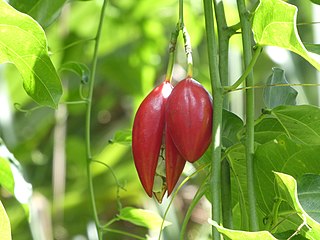
Araucaria heterophylla is a species of conifer. As its vernacular name Norfolk Island pine implies, the tree is endemic to Norfolk Island, an external territory of Australia located in the Pacific Ocean between New Zealand and New Caledonia. It is not a true pine, which belong to the genus Pinus in the family Pinaceae, but instead is a member of the genus Araucaria, in the family Araucariaceae, which also contains the hoop pine. Members of Araucaria occur across the South Pacific, especially concentrated in New Caledonia where 13 closely related and similar-appearing species are found. It is sometimes called a star pine, Polynesian pine, triangle tree or living Christmas tree, due to its symmetrical shape as a sapling.

Collinsia heterophylla, known as purple Chinese houses or innocence, is a flowering plant native to California and the Peninsular Ranges in northern Baja California.

Euphorbia heterophylla, also known under the common names of Mexican fireplant, painted euphorbia, Japanese poinsettia, paintedleaf, painted spurge and milkweed, is a plant belonging to the Euphorbiaceae or spurge family.

Austromuellera is a genus of only two known species of medium-sized trees, constituting part of the plant family Proteaceae. They are both endemic to three restricted areas of the wet tropics rainforests of north-eastern Queensland, Australia. The genus was named in 1930 in honour of Ferdinand von Mueller by Cyril T. White. They lie within the tribe Banksieae within the family Proteaceae, their closest relatives the genera Musgravea and Banksia.

Musgravea is a genus of rainforest tree from north-eastern Queensland.

Notogrammitis heterophylla is a species of fern within the family polypodiaceae ferns. The species is found in New Zealand, Tasmania and Victoria, Australia. This plant is epiphytic In New Zealand's Westland N. heterophylla occurs in association with other epiphytes such as Asplenium polyodon and Trichomanes reniforme.

Drosera heterophylla, the swamp rainbow, is an erect perennial tuberous species in the carnivorous plant genus Drosera that is endemic to Western Australia. It grows in shallow water swamps or wet clay flats near granite outcrops and occurs in the vicinity of Perth and to its north. D. heterophylla produces small leaves along an erect stem that can be 10–30 cm (4–12 in) tall. It is the only species in the genus that produces many-petaled flowers. These white flowers emerge from June to September.

Agoseris heterophylla is a liguliferous species in the family Asteraceae known by the common name annual agoseris or mountain dandelion. It is widespread in mostly drier regions of western North America from British Columbia to Baja California.

Billardiera heterophylla is a species of flowering plant in the family Pittosporaceae, known by the common name bluebell creeper. It is native to Western Australia, but is grown as an ornamental plant in appropriate climates worldwide. It can sometimes be found growing in the wild as an introduced species or garden escapee, for example in other Australian states and in California, where it is popular in landscaping. It is sometimes considered a weed.

Bossiaea heterophylla, commonly known as variable bossiaea, is a species of flowering plant in the family Fabaceae and is endemic to south-eastern Australia. It is a variable shrub with flattened stems, egg-shaped to linear leaves, and yellow and dark red flowers.

Lobelia heterophylla is a blue to purple flowered herb found in Southern Australia. The specific epithet refers to the variety of leaf forms found on individual plants. The species was first described by Jacques Labillardière in his seminal work on Australian flora, Novae Hollandiae Plantarum Specimen. L. heterophylla has a wide distribution, due to its ability to inhabit a variety of soil types. The habit of the herbaceous plant is erect, up to 0.6 metres, with flowers appearing from August or October to December, or January to February. The flower whorl is deeply cleft, its colour range of blue, scarlet or purple is well known and it is considered to be a desirable specimen for use in gardens. The plant is commonly referred to as wing-seeded lobelia and Australian blue creeper. The species was featured and illustrated by Joseph Paxton in 1838.
Silky oak is a common name for Grevillea robusta.

Opisthiolepis is a genus of a sole described species of large trees, constituting part of the plant family Proteaceae. The species Opisthiolepis heterophylla most commonly has the names of blush silky oak, pink silky oak, brown silky oak and drunk rabbit.

Volkameria heterophylla is a species of flowering plant in the genus Volkameria of the family Lamiaceae. It is a native to Mauritius and La Réunion.
Musgravea stenostachya, commonly known as the crater oak or grey silky oak, is a species of rainforest tree of the family Proteaceae from north-eastern Queensland. It was described in 1890 by Ferdinand von Mueller, having been collected on Mount Bellenden-Ker.

Tabebuia heterophylla is a species of tree native to the Caribbean, and is also cultivated. It is also known as Roble blanco, pink manjack, pink trumpet tree, white cedar, and whitewood.

Petrophile heterophylla, commonly known as the variable-leaved conebush, is a species of flowering plant in the family Proteaceae and is endemic to southwestern Western Australia. It is a shrub with variably shaped, sometimes pinnately-divided leaves, and oval heads of silky-hairy, yellow to cream-coloured flowers.

Goodenia heterophylla is a species of plant in the family Goodeniaceae and is endemic to eastern Australia. It is an erect to trailing, more or less woody herb or shrub with linear to egg-shaped stem-leaves and racemes or thyrses of yellow flowers.

Agalinis heterophylla is a species of flowering plant in the family Orobanchaceae known as prairie false foxglove. It is found in northern Mexico (Tamaulipas) and the southeastern and central United States.

Adenia heterophylla, commonly known in Australia as the lacewing vine, is a climbing plant in the family Passifloraceae. It has a broad distribution spanning the equator, from the south eastern corner of China, through Indochina and Malesia, to northern Australia. In Australia it serves as a food plant for larvae of the glasswing, red lacewing and cruiser butterflies.


















